[English] 日本語
 Yorodumi
Yorodumi- PDB-7coy: Structure of the far-red light utilizing photosystem I of Acaryoc... -
+ Open data
Open data
- Basic information
Basic information
| Entry | Database: PDB / ID: 7coy | ||||||||||||||||||
|---|---|---|---|---|---|---|---|---|---|---|---|---|---|---|---|---|---|---|---|
| Title | Structure of the far-red light utilizing photosystem I of Acaryochloris marina | ||||||||||||||||||
 Components Components |
| ||||||||||||||||||
 Keywords Keywords | PHOTOSYNTHESIS / Photosystem I / Acaryochloris marina / Light-harvesting / Chlorophyll d | ||||||||||||||||||
| Function / homology |  Function and homology information Function and homology informationphotosystem I reaction center / photosystem I / photosynthetic electron transport in photosystem I / photosystem I / chlorophyll binding / plasma membrane-derived thylakoid membrane / photosynthesis / endomembrane system / 4 iron, 4 sulfur cluster binding / electron transfer activity ...photosystem I reaction center / photosystem I / photosynthetic electron transport in photosystem I / photosystem I / chlorophyll binding / plasma membrane-derived thylakoid membrane / photosynthesis / endomembrane system / 4 iron, 4 sulfur cluster binding / electron transfer activity / oxidoreductase activity / magnesium ion binding / metal ion binding Similarity search - Function | ||||||||||||||||||
| Biological species |  Acaryochloris marina MBIC11017 (bacteria) Acaryochloris marina MBIC11017 (bacteria) Acaryochloris marina MBIC110017 (bacteria) Acaryochloris marina MBIC110017 (bacteria) Acaryochloris marina MBIC 11017 (bacteria) Acaryochloris marina MBIC 11017 (bacteria) | ||||||||||||||||||
| Method | ELECTRON MICROSCOPY / single particle reconstruction / cryo EM / Resolution: 2.5 Å | ||||||||||||||||||
 Authors Authors | Kawakami, K. / Yonekura, K. / Hamaguchi, T. / Kashino, Y. / Shinzawa-Itoh, K. / Inoue-Kashino, N. / Itoh, S. / Ifuku, K. / Yamashita, E. | ||||||||||||||||||
| Funding support |  Japan, 5items Japan, 5items
| ||||||||||||||||||
 Citation Citation |  Journal: Nat Commun / Year: 2021 Journal: Nat Commun / Year: 2021Title: Structure of the far-red light utilizing photosystem I of Acaryochloris marina. Authors: Tasuku Hamaguchi / Keisuke Kawakami / Kyoko Shinzawa-Itoh / Natsuko Inoue-Kashino / Shigeru Itoh / Kentaro Ifuku / Eiki Yamashita / Kou Maeda / Koji Yonekura / Yasuhiro Kashino /  Abstract: Acaryochloris marina is one of the cyanobacterial species that can use far-red light to drive photochemical reactions for oxygenic photosynthesis. Here, we report the structure of A. marina ...Acaryochloris marina is one of the cyanobacterial species that can use far-red light to drive photochemical reactions for oxygenic photosynthesis. Here, we report the structure of A. marina photosystem I (PSI) reaction center, determined by cryo-electron microscopy at 2.58 Å resolution. The structure reveals an arrangement of electron carriers and light-harvesting pigments distinct from other type I reaction centers. The paired chlorophyll, or special pair (also referred to as P740 in this case), is a dimer of chlorophyll d and its epimer chlorophyll d'. The primary electron acceptor is pheophytin a, a metal-less chlorin. We show the architecture of this PSI reaction center is composed of 11 subunits and we identify key components that help explain how the low energy yield from far-red light is efficiently utilized for driving oxygenic photosynthesis. | ||||||||||||||||||
| History |
|
- Structure visualization
Structure visualization
| Movie |
 Movie viewer Movie viewer |
|---|---|
| Structure viewer | Molecule:  Molmil Molmil Jmol/JSmol Jmol/JSmol |
- Downloads & links
Downloads & links
- Download
Download
| PDBx/mmCIF format |  7coy.cif.gz 7coy.cif.gz | 1.4 MB | Display |  PDBx/mmCIF format PDBx/mmCIF format |
|---|---|---|---|---|
| PDB format |  pdb7coy.ent.gz pdb7coy.ent.gz | Display |  PDB format PDB format | |
| PDBx/mmJSON format |  7coy.json.gz 7coy.json.gz | Tree view |  PDBx/mmJSON format PDBx/mmJSON format | |
| Others |  Other downloads Other downloads |
-Validation report
| Summary document |  7coy_validation.pdf.gz 7coy_validation.pdf.gz | 14.6 MB | Display |  wwPDB validaton report wwPDB validaton report |
|---|---|---|---|---|
| Full document |  7coy_full_validation.pdf.gz 7coy_full_validation.pdf.gz | 15.6 MB | Display | |
| Data in XML |  7coy_validation.xml.gz 7coy_validation.xml.gz | 275.2 KB | Display | |
| Data in CIF |  7coy_validation.cif.gz 7coy_validation.cif.gz | 363.2 KB | Display | |
| Arichive directory |  https://data.pdbj.org/pub/pdb/validation_reports/co/7coy https://data.pdbj.org/pub/pdb/validation_reports/co/7coy ftp://data.pdbj.org/pub/pdb/validation_reports/co/7coy ftp://data.pdbj.org/pub/pdb/validation_reports/co/7coy | HTTPS FTP |
-Related structure data
| Related structure data |  30420MC M: map data used to model this data C: citing same article ( |
|---|---|
| Similar structure data |
- Links
Links
- Assembly
Assembly
| Deposited unit | 
|
|---|---|
| 1 |
|
- Components
Components
-Photosystem I P700 chlorophyll a apoprotein ... , 2 types, 6 molecules aAbAcAaBbBcB
| #1: Protein | Mass: 83470.539 Da / Num. of mol.: 3 / Source method: isolated from a natural source / Source: (natural)  Acaryochloris marina MBIC11017 (bacteria) / Strain: MBIC 11017 / References: UniProt: B0C474, photosystem I Acaryochloris marina MBIC11017 (bacteria) / Strain: MBIC 11017 / References: UniProt: B0C474, photosystem I#2: Protein | Mass: 82210.555 Da / Num. of mol.: 3 / Source method: isolated from a natural source Source: (natural)  Acaryochloris marina MBIC110017 (bacteria) Acaryochloris marina MBIC110017 (bacteria)Strain: MBIC 11017 / References: UniProt: B0C475, photosystem I |
|---|
-Protein , 1 types, 3 molecules aCbCcC
| #3: Protein | Mass: 8825.207 Da / Num. of mol.: 3 / Source method: isolated from a natural source Source: (natural)  Acaryochloris marina MBIC110017 (bacteria) Acaryochloris marina MBIC110017 (bacteria)Strain: MBIC 11017 / References: UniProt: B0CB42, photosystem I |
|---|
-Photosystem I protein ... , 5 types, 15 molecules aDbDcDaFbFcFaIbIcIaLbLcLaMbMcM
| #4: Protein | Mass: 15114.146 Da / Num. of mol.: 3 / Source method: isolated from a natural source Source: (natural)  Acaryochloris marina MBIC110017 (bacteria) Acaryochloris marina MBIC110017 (bacteria)Strain: MBIC 11017 / References: UniProt: B0C8F1 #6: Protein | Mass: 17844.621 Da / Num. of mol.: 3 / Source method: isolated from a natural source Source: (natural)  Acaryochloris marina MBIC110017 (bacteria) Acaryochloris marina MBIC110017 (bacteria)Strain: MBIC 11017 / References: UniProt: B0C7S7 #7: Protein/peptide | Mass: 3648.337 Da / Num. of mol.: 3 / Source method: isolated from a natural source / Source: (natural)  Acaryochloris marina MBIC11017 (bacteria) / Strain: MBIC 11017 Acaryochloris marina MBIC11017 (bacteria) / Strain: MBIC 11017#10: Protein | Mass: 15349.588 Da / Num. of mol.: 3 / Source method: isolated from a natural source Source: (natural)  Acaryochloris marina MBIC 11017 (bacteria) Acaryochloris marina MBIC 11017 (bacteria)Strain: MBIC 11017 / References: UniProt: B0C7S4 #11: Protein/peptide | Mass: 3190.899 Da / Num. of mol.: 3 / Source method: isolated from a natural source / Source: (natural)  Acaryochloris marina MBIC11017 (bacteria) / Strain: MBIC 11017 Acaryochloris marina MBIC11017 (bacteria) / Strain: MBIC 11017 |
|---|
-Photosystem I reaction center subunit ... , 3 types, 9 molecules aEbEcEaJbJcJaKbKcK
| #5: Protein | Mass: 9560.822 Da / Num. of mol.: 3 / Source method: isolated from a natural source Source: (natural)  Acaryochloris marina MBIC110017 (bacteria) Acaryochloris marina MBIC110017 (bacteria)Strain: MBIC 11017 / References: UniProt: B0C5D5 #8: Protein | Mass: 5900.939 Da / Num. of mol.: 3 / Source method: isolated from a natural source Source: (natural)  Acaryochloris marina MBIC110017 (bacteria) Acaryochloris marina MBIC110017 (bacteria)Strain: MBIC 11017 / References: UniProt: B0C7S6 #9: Protein | Mass: 9289.071 Da / Num. of mol.: 3 / Source method: isolated from a natural source Source: (natural)  Acaryochloris marina MBIC 11017 (bacteria) Acaryochloris marina MBIC 11017 (bacteria)Strain: MBIC 11017 / References: UniProt: B0CA71 |
|---|
-Non-polymers , 9 types, 363 molecules 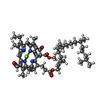

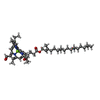

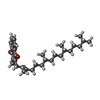










| #12: Chemical | | #13: Chemical | ChemComp-PHO / #14: Chemical | ChemComp-CL7 / #15: Chemical | ChemComp-UNL / Num. of mol.: 36 / Source method: obtained synthetically / Feature type: SUBJECT OF INVESTIGATION #16: Chemical | ChemComp-LHG / #17: Chemical | ChemComp-PQN / #18: Chemical | ChemComp-SF4 / #19: Chemical | #20: Water | ChemComp-HOH / | |
|---|
-Details
| Has ligand of interest | Y |
|---|---|
| Has protein modification | Y |
| Nonpolymer details | Authors state that Photosystem I from Acaryochloris marina contains alfa-carotene instead of beta- ...Authors state that Photosystem I from Acaryochloris marina contains alfa-carotene instead of beta-carotene. The alfa-carotene molecule possesses two rings (known as beta- and epsilon-rings) at each end, while the beta-carotene possesses two beta-rings. From the cryo-EM density map, they could not distinguish the difference between beta- and epsilon-ring, because the only difference between beta- and epsilon-ring is the arrangement of the hydrogen atom. Therefore such unclear molecules have been assigned to UNL. |
-Experimental details
-Experiment
| Experiment | Method: ELECTRON MICROSCOPY |
|---|---|
| EM experiment | Aggregation state: PARTICLE / 3D reconstruction method: single particle reconstruction |
- Sample preparation
Sample preparation
| Component | Name: Photosystem I complex from Acaryochloris marina / Type: COMPLEX / Entity ID: #1-#11 / Source: NATURAL |
|---|---|
| Source (natural) | Organism:  Acaryochloris marina (bacteria) Acaryochloris marina (bacteria) |
| Buffer solution | pH: 6.5 |
| Specimen | Embedding applied: NO / Shadowing applied: NO / Staining applied: NO / Vitrification applied: YES |
| Vitrification | Cryogen name: NITROGEN |
- Electron microscopy imaging
Electron microscopy imaging
| Microscopy | Model: JEOL CRYO ARM 300 |
|---|---|
| Electron gun | Electron source:  FIELD EMISSION GUN / Accelerating voltage: 300 kV / Illumination mode: FLOOD BEAM FIELD EMISSION GUN / Accelerating voltage: 300 kV / Illumination mode: FLOOD BEAM |
| Electron lens | Mode: BRIGHT FIELD |
| Image recording | Electron dose: 85.7 e/Å2 / Film or detector model: GATAN K2 SUMMIT (4k x 4k) |
- Processing
Processing
| CTF correction | Type: PHASE FLIPPING AND AMPLITUDE CORRECTION |
|---|---|
| 3D reconstruction | Resolution: 2.5 Å / Resolution method: FSC 0.143 CUT-OFF / Num. of particles: 86419 / Symmetry type: POINT |
| Refinement | Highest resolution: 2.5 Å |
 Movie
Movie Controller
Controller




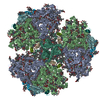
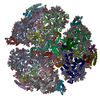

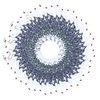

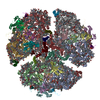
 PDBj
PDBj

















